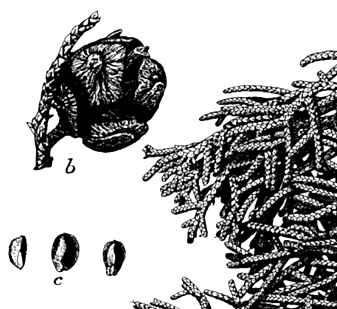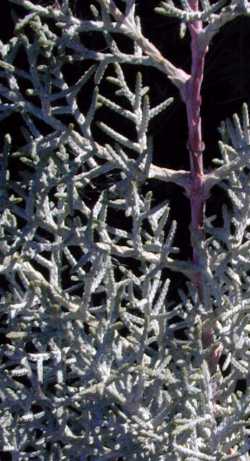Arizona Cypress
Scientific Name: Cupressus arizonica Greene
Synonym: Cupressus glabra
Family: Cupressaceae
Sunset®: 5,8-24,26-31
USDA: 5b-11
Frost Tolerance: Hardy to -15°F (-30°C)
Sun Exposure: Full sun
Origin: USA (central Arizona)
Growth Habits: Evergreen tree, up to 40 feet tall (12 m), 20 feet spread (6 m)
Watering Needs: Very little to no water when established (2 to 3 years after planting)
Propagation: Seeds

Arizona Cypress (Cupressus arizonica), U.S.D.A. Drawing, courtesy Hunt Institute
Cupressus arizonica Greene, Arizona cypress, is the only cypress native to the southwest. It is a medium sized tree 50 to 60 feet tall and 15 to 30 inches in diameter. It is evergreen, with a dense, upright, conical crown and smooth reddish-brown bark that sometimes becomes fibrous with flat ridges. Leaves are scale-like and grayish-green, bluish-green, or silvery, arranged opposite in pairs and tightly clasping the cord-like or four-sided twigs; they emit a fetid odor when crushed. The cones are 3/4 to 1 inch in diameter, subglobose, dark reddish brown, with 6 to 8 shield-shaped woody scales. The cones mature in autumn of the second season but persist on the tree for many years.
Culture:
It is found naturally on dry, sterile, rocky mountain slopes and canyon walls, but does very well when planted on better soils or when irrigated. It requires a minimum of 10 to 12 inches of water annually. It is not recommended for elevations of over 3,000 feet nor is it recommended for soils with a high water table. It requires full sunlight for best development, but is subject to sunscald when grown as an ornamental. Though it grows slowly under natural dry conditions, it is a rapid grower (up to 3 feet per year) on better soils with a good moisture regime.
Arizona cypress generally requires little maintenance. Deep watering at least every other week is necessary for desert planting during the growing season. Arizona cypress is especially susceptible to fire and needs proper protection.
Arizona cypress ordinarily has few disease pests, but when grown in areas of high humidity, incidence of disease increases. Principal enemies are mistletoes and rusts. The cypress bark beetle may be troublesome by mining twigs on ornamentals.
Source USDA/NRCS
Propagation:
Arizona cypress is usually available as 1 year old potted stock. It should be planted in areas where there is at least 10 to 12 inches of water available annually either naturally or through irrigation. Early spring is the best time for planting. For windbreaks 6-foot spacing in rows is recommended. Open sunlight is required for best growth.
Desert-Tropicals is dedicated to provide gardening advice, gardening ideas, and information about flower of all kind for landscape and collections.We try to check carefully the identification of the plants on the illustrations as well as the other information from the page, but occasionally errors do occur. if you notice anything that needs to be changed please contact us.Thanks.
© 1998-2020 Philippe Faucon, All Rights Reserved.
